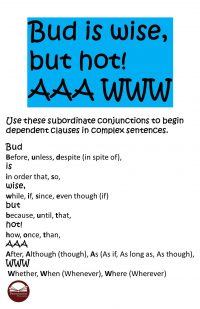How to Write Complex Sentences
More and more candidates for better paying jobs are now required to submit writing samples as part of the interview process. Many applicants with strong verbal skills fail to make the second round of interviews because of their poor writing samples. Frequently, the problems are not unity or coherence, or even inadequate vocabulary/word choice. All too often, poor writers are categorized as such because they only write in simple or compound sentences. A few tips on how to improve writing, using complex sentences will get you through to that second round of interviews.
A Few Definitions and Examples
A simple sentence has a noun (person, place, thing, or idea), a verb (mental or physical action or “to-be” verb—is, am, are, was, were, be, being, been), and the rest of the sentence (known as the complement).
Example: John ran down the street.
A compound sentence combines two simple sentences with a conjunction (a connecting word such as and, but, or so).
Example: John ran down the street, and he saw the crime take place.
A complex sentence has an independent clause and at least one dependent clause. An independent clause means that there is a noun and a verb that express a complete thought. A dependent (subordinate) clause means that there is a noun and a verb that do not express a complete thought.
Example:
Ty completed all his chores (independent clause) + after eating his lunch (dependent clause) = Ty completed all his chores after eating his lunch.
How to Form Complex Sentences
Complex sentences can help define the relationship between complicated ideas and will make your writing more specific and interesting to read. Learn how to improve writing by adding dependent clauses to the beginning, middle, or end of your simple or compound sentences. Oh, by the way, if starting a sentence with a dependent clause, always follow the clause with a comma.
Dependent Clauses
To improve writing, add adjective clauses, which describe nouns or pronouns. Transitions beginning adjective clauses include who, whose, on (for, of) whom to refer to people, that to refer to people or things, and which to refer only to things.
Example: whose work is well-known
To improve writing, add adverbial clauses, which describe describe an adjective, an adverb, or verb. A subordinating conjunction always introduces an adverbial clause. The subordinating conjunction signals the relationship between the adverbial clause and the independent clause. Use a comma to set off an introductory adverbial clause, but not an adverbial clause that ends a sentence. Use this memory trick to remember the subordinating conjunctions:
Bud is wise, but hot! AAA WWW
before, unless, despite (in spite of), in order that, so, while, if, since, even though (if), because, until, that, how, once, than, after, although (though), as (as if, as long as, as though), whether, when (whenever), where (wherever)
Example: as long as she can wait
To improve writing, add noun clauses, which describe are used as a subject, a complement (the rest of the sentence besides the subject and predicate), or as the object of a preposition. Transitions beginning noun clauses include that, what, whatever, which, whichever, who, whoever, whom, and whomever.
Example: whatever he demands
*****

Pennington Publishing Grammar Programs
Teaching Grammar, Usage, and Mechanics (Grades 4, 5, 6, 7, 8, and High School) are full-year, traditional, grade-level grammar, usage, and mechanics programs with plenty of remedial practice to help students catch up while they keep up with grade-level standards. Twice-per-week, 30-minute, no prep lessons in print or interactive Google slides with a fun secret agent theme. Simple sentence diagrams, mentor texts, video lessons, sentence dictations. Plenty of practice in the writing context. Includes biweekly tests and a final exam.
Grammar, Usage, and Mechanics Interactive Notebook (Grades 4‒8) is a full-year, no prep interactive notebook without all the mess. Twice-per-week, 30-minute, no prep grammar, usage, and mechanics lessons, formatted in Cornell Notes with cartoon response, writing application, 3D graphic organizers (easy cut and paste foldables), and great resource links. No need to create a teacher INB for student make-up work—it’s done for you! Plus, get remedial worksheets, biweekly tests, and a final exam.
Syntax in Reading and Writing is a function-based, sentence-level syntax program, designed to build reading comprehension and increase writing sophistication. The 18 parts of speech, phrases, and clauses lessons are each leveled from basic (elementary) to advanced (middle and high school) and feature 5 lesson components (10–15 minutes each): 1. Learn It! 2. Identify It! 3. Explain It! (analysis of challenging sentences) 4. Revise It! (kernel sentences, sentence expansion, syntactic manipulation) 5. Create It! (Short writing application with the syntactic focus in different genre).
Get the Diagnostic Grammar, Usage, and Mechanics Assessments, Matrix, and Final Exam FREE Resource:
![]()
